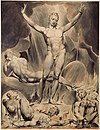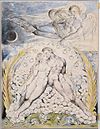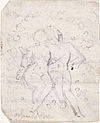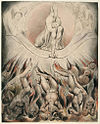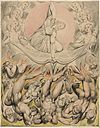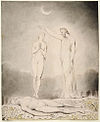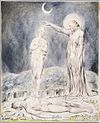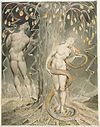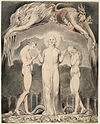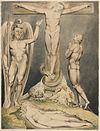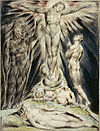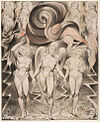
William Blake was an English poet, painter, and printmaker. Largely unrecognised during his life, Blake is now considered a seminal figure in the history of the poetry and visual art of the Romantic Age. What he called his "prophetic works" were said by 20th-century critic Northrop Frye to form "what is in proportion to its merits the least read body of poetry in the English language". While he lived in London his entire life, except for three years spent in Felpham, he produced a diverse and symbolically rich collection of works, which embraced the imagination as "the body of God", or "human existence itself".
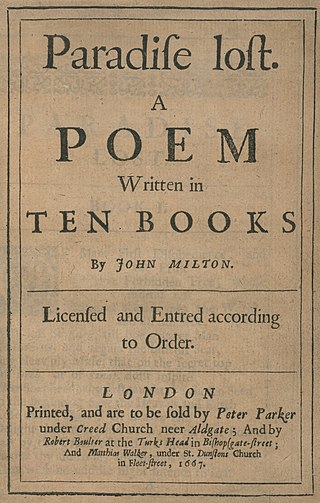
Paradise Lost is an epic poem in blank verse by the 17th-century English poet John Milton (1608–1674). The first version, published in 1667, consists of ten books with over ten thousand lines of verse. A second edition followed in 1674, arranged into twelve books with minor revisions throughout. It is considered to be Milton's masterpiece, and it helped solidify his reputation as one of the greatest English poets of all time. The poem concerns the biblical story of the fall of man: the temptation of Adam and Eve by the fallen angel Satan and their expulsion from the Garden of Eden.
The prophetic books of the English poet and artist William Blake contain an invented mythology, in which Blake worked to encode his spiritual and political ideas into a prophecy for a new age. This desire to recreate the cosmos is the heart of his work and his psychology. His myths often described the struggle between enlightenment and free love on the one hand, and restrictive education and morals on the other.

Jerusalem: The Emanation of the Giant Albion is a prophetic book by English poet William Blake. Jerusalem is the last, longest and greatest in scope of Blake's works. Etched in handwriting, accompanied by small sketches, marginal figures and huge full-plate illustrations, it has been described as "visionary theatre". The poet himself believed it was his masterpiece and it has been said that "of all Blake's illuminated epics, this is by far the most public and accessible". Nonetheless, only six copies were printed in Blake's lifetime and the book, like all of Blake's prophetic works, was all but ignored by his contemporaries.

Enitharmon is a major female character in William Blake's mythology, playing a main part in some of his prophetic books. She is, but not directly, an aspect of the male Urthona, one of the Four Zoas. She is in fact the Emanation of Los, also male. There is a complex verbal nexus attached. The Zoa Tharmas has emanation Enion, and Eni-tharm(as)-on is one derivation of her name. That should perhaps be read in the inverse direction though, as a construction of the Tharmas/Enion pair's names. Within Blake's myth, she represents female domination and sexual restraints that limit the artistic imagination. She, with Los, gives birth to various children, including Orc.

In the mythological writings of William Blake, Tharmas is one of the four Zoas, who were created when Albion, the primordial man, was divided fourfold. He represents sensation, and his female counterpart is Enion, who represents sexual urges. He is connected to the God the Father aspect of the Christian Trinity and is the begetter of Los. Tharmas is mostly peaceful, and flees during most of his fights with Urizen. He is depicted in various ways ranging from a youth with wings to an old bearded man.
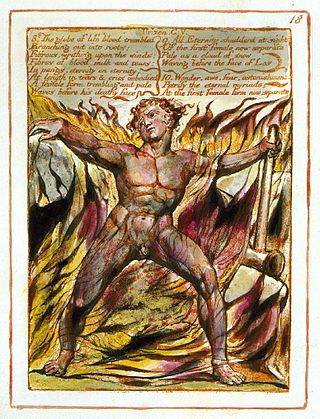
In the mythological writings of William Blake, Los is the fallen form of Urthona, one of the four Zoas, and the embodiment of human creativity and inspiration. He is referred to as the "eternal prophet" and creates the visionary city of Golgonooza. Los is regularly described as a smith, beating with his hammer on a forge, which is metaphorically connected to the beating of the human heart. The bellows of his forge are the human lungs. Los's emanation, Enitharmon, represents spiritual beauty and embodies pity, but at the same time creates the spatial aspect of the fallen world, weaving bodies for men and creating sexual strife through her insistence upon chastity. In the Book of Urizen (1794), Los and Enitharmon have a child, Orc, who is the embodiment of the spirit of revolution. The name Los is, by common critical acceptance, an anagram of Sol, the Latin word for "sun". Los is also the plural form of El, an ancient Hebrew deity. Such innovations are common in many of Blake's prophetic poems.

A Preface to Paradise Lost is one of C. S. Lewis's most famous scholarly works. The book had its genesis in Lewis's Ballard Matthews Lectures, which he delivered at the University College of North Wales in 1941. It discusses the epic poem Paradise Lost, by John Milton.

William Blake's Illustrations of the Book of Job primarily refers to a series of twenty-two engraved prints by Blake illustrating the biblical Book of Job. It also refers to two earlier sets of watercolours by Blake on the same subject. The engraved Illustrations are considered to be Blake's greatest masterpieces in the medium of engraving, and were also a rare commercial and critical success for Blake.

Vala, or The Four Zoas is one of the uncompleted prophetic books by the English poet William Blake, begun in 1797. The eponymous main characters of the book are the Four Zoas, who were created by the fall of Albion in Blake's mythology. It consists of nine books, referred to as "nights". These outline the interactions of the Zoas, their fallen forms and their Emanations. Blake intended the book to be a summation of his mythic universe but, dissatisfied, he abandoned the effort in 1807, leaving the poem in a rough draft and its engraving unfinished. The text of the poem was first published, with only a small portion of the accompanying illustrations, in 1893, by the Irish poet W. B. Yeats and his collaborator, the English writer and poet Edwin John Ellis, in their three-volume book The Works of William Blake.
The religious views of John Milton influenced many of his works focusing on the nature of religion and of the divine. He differed in important ways from the Calvinism with which he is associated, particularly concerning the doctrines of grace and predestination. The unusual nature of his own Protestant Christianity has been characterized as both Puritan and Independent.

Sir John Baptist Medina or John Baptiste de Medina was an artist of Flemish-Spanish origin who worked in England and Scotland, mostly as a portrait painter, though he was also the first illustrator of Paradise Lost by John Milton in 1688.

William Blake drew and painted illustrations for John Milton's nativity ode On the Morning of Christ's Nativity between 1803 and 1815. A total of 16 illustrations are extant: two sets of six watercolours each, and an additional four drawings in pencil.

A Vision of the Last Judgement is a painting by William Blake that was designed in 1808 before becoming a lost artwork. The painting was to be shown in an 1810 exhibition with a detailed analysis added to a second edition of his Descriptive Catalogue. This plan was dropped after the exhibition was cancelled, and the painting disappeared. Blake's notes for the Descriptive Catalogue describe various aspects of the work in a detailed manner, which allow the aspects of the painting to be known. Additionally, earlier designs that reveal similar Blake depiction of the Last Judgement have survived, and these date back to an 1805 precursor design created for Robert Blair's The Grave. In addition to Blake's notes on the painting, a letter written to Ozias Humphrey provides a description of the various images within an earlier design of the Last Judgement.
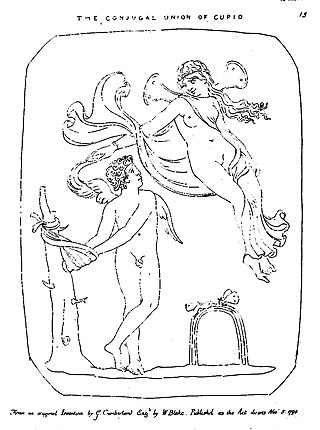
George Cumberland was an English art collector, writer and poet. He was a lifelong friend and supporter of William Blake, and like him was an experimental printmaker. He was also an amateur watercolourist, and one of the earliest members of the Bristol School of artists. He made use of his wide circle of connections to help its other members, in particular assisting and influencing Edward Bird and Francis Danby.

Satan Presiding at the Infernal Council is part of a series of 48 mezzotint engravings that British artist John Martin created between 1823 and 1827 to illustrate a new edition of Milton's Paradise Lost. It was described by The Guardian in 2011 as "Satan holding court in what looks like a solo performance in the Albert Hall ".

The Visionary Heads is a series of black chalk and pencil drawings produced by William Blake after 1818 by request of John Varley, the watercolour artist and astrologer. The subjects of the sketches, many of whom are famous historical and mythical characters, appeared to Blake in visions during late night meetings with Varley, as if sitting for portraits. The drawings are contained in three sketchbooks and there are a number of loose leaves indicating the existence of a fourth sketchbook. Like most of Blake's other works, they have been subject to academic scrutiny and study.

The Agony in the Garden is a small painting by William Blake, completed as part of his 1799–1800 series of Bible illustrations commissioned by his patron and friend Thomas Butts. The work illustrates a passage from the Gospel of Luke which describes Christ's turmoil in the Garden of Gethsemane before his arrest and Crucifixion following Judas's betrayal. In Blake's painting a brilliantly coloured and majestic angel breaks through the surrounding darkness and descends from a cloud to aid and physically support Jesus in his hour of agony. The work is dominated by vertical lines, formed both from the trees and from the two arms of the angel. Two inner lines converge on Christ's palms, evoking the nails driven through him during his crucifixion.

Expulsion from the Garden of Eden was painted in 1828 by English-born American painter Thomas Cole. It belongs to the collection of the Museum of Fine Arts, Boston and is on display in their Waleska Evans James Gallery. This landscape painting exemplifies the style of the Hudson River School, which was a group of American landscape painters that Thomas Cole is credited with founding, and is knotted. On the lower left part of the cliff, Cole signed his name as "T Cole".
The Expulsion of the Garden of Eden or the Expulsion from Paradise refers to the Biblical account of the ejection of Adam and Eve from the Garden of Eden as part of the Fall of man.



